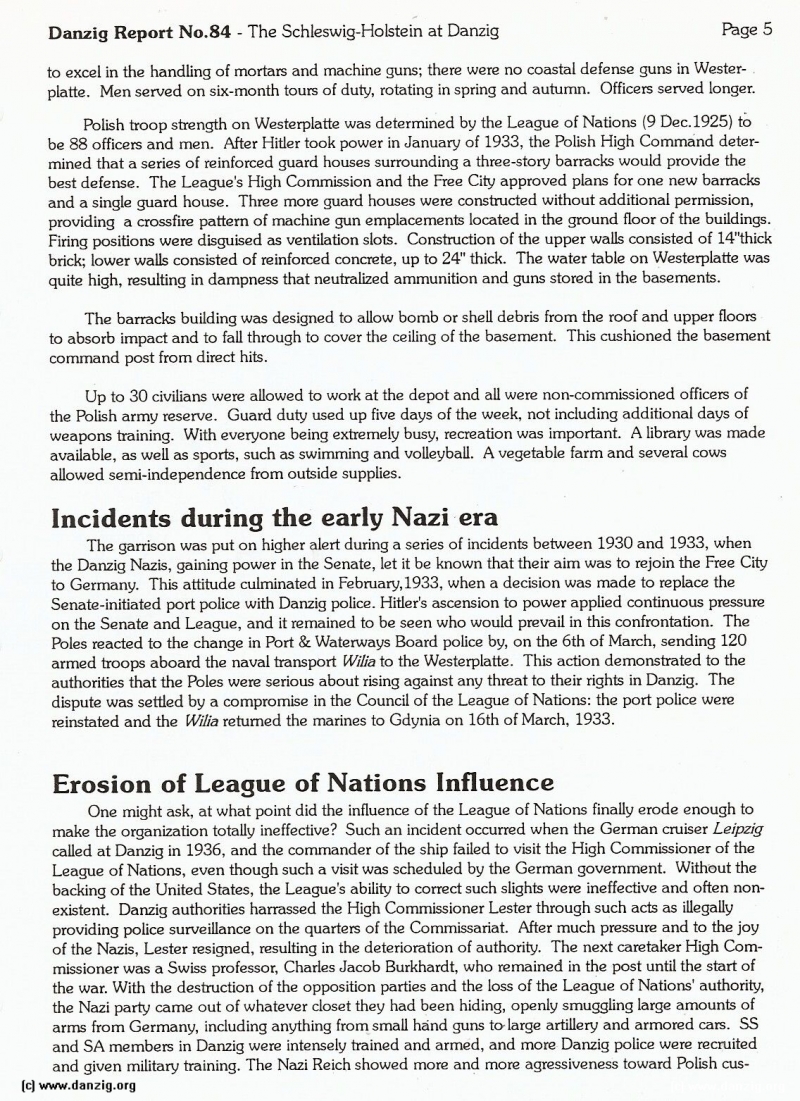
to excel in the handling of mortars and machine guns; there were no coastal defense guns in Westerp latte. Men served on six-month tours of duty, rotating in spring and autumn. Officers served longer.
Polish troop strength on Westerplatte was determined by the League of Nations (9 Dec.1925) to be 88 officers and men. After Hitler took power in January of 1933, the Polish High Command determ ined that a series of reinforced guard houses surrounding a three-story barracks would provide the best defense. The League’s High Commission and the Free City approved plans for one new barracks and a single guard house. Three more guard houses were constructed without additional permission, providing a crossfire pattern of machine gun emplacements located in the ground floor of the buildings. Firing positions were disguised as ventilation slots. Construction of the upper walls consisted of 14”thick brick; lower walls consisted of reinforced concrete, up to 24” thick. The water table on Westerplatte was quite high, resulting in dampness that neutralized ammunition and guns stored in the basements.
The barracks building was designed to allow bomb or shell debris from the roof and upper floors to absorb impact and to fall through to cover the ceiling of the basement. This cushioned the basement command post from direct hits.
Up to 30 civilians were allowed to work at the depot and all were non-commissioned officers of the Polish army reserve. Guard duty used up five days of the week, not including additional days of weapons training. With everyone being extremely busy, recreation was important. A library was made available, as well as sports, such as swimming and volleyball. A vegetable farm and several cows allowed semi-independence from outside supplies.
Incidents during the early Nazi era
The garrison was put on higher alert during a series of incidents between 1930 and 1933, when the Danzig Nazis, gaining power in the Senate, let it be known that their aim was to rejoin the Free City to Germany. This attitude culminated in February, 1933, when a decision was made to repLace the Senate-initiated port police with Danzig police. Hitler’s ascension to power applied continuous pressure on the Senate and League, and it remained to be seen who would prevail in this confrontation. The Poles reacted to the change in Port & Waterways Board police by, on the 6th of March, sending 120 armed troops aboard the naval transport Wi/ia to the Westerplatte. This action demonstrated to the authorities that the Poles were serious about rising against any threat to their rights in Danzig. The dispute was settled by a compromise in the Council of the League of Nations: the port police were reinstated and the Wi/ia returned the marines to Gdynia on 16th of March, 1933.
Erosion of League of Nations Influence
One might ask, at what point did the influence of the League of Nations finally erode enough to make the organization totally ineffective? Such an incident occurred when the German cruiser Leipzig called at Danzig in 1936, and the commander of the ship failed to visit the High Commissioner of the League of Nations, even though such a visit was scheduled by the German government. Without the backing of the United States, the League’s ability to correct such slights were ineffective and often none xistent. Danzig authorities harrassed the High Commissioner Lester through such acts as illegally providing police surveillance on the quarters of the Commissariat. After much pressure and to the joy of the Nazis, Lester resigned, resulting in the deterioration of authority. The next caretaker High Comm issioner was a Swiss professor, Charles Jacob Burkhardt, who remained in the post until the start of the war. With the destruction of the opposition parties and the loss of the League of Nations’ authority, the Nazi party came out of whatever closet they had been hiding, openly smuggling large amounts of arms from Germany, including anything from small hand guns t& large artillery and armored cars. SS and SA members in Danzig were intensely trained and armed, and more Danzig police were recruited and given military training. The Nazi Reich showed more and more agressiveness toward Polish cus
Danzig Report Vol. 1 - Nr. 84 - July - August - Sept - 1994, Page 5.
Hits: 3973
Added: 09/07/2015
Copyright: 2025 Danzig.org

